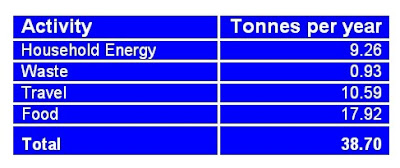A Goal to Cancel Personally Controllable Carbon EmissionsIn this article we will look at the benefits of using an individual’s average controllable carbon emissions as a goal to reduce carbon emissions credits as opposed to reducing a carbon footprint. If every individual in the developed world cancelled 12 tonnes of carbon emissions credits it would amount to about 14.7 billion tonnes of carbon dioxide. That is about half the world’s total annual carbon emissions!

There are many definitions of a carbon footprint. In general, it provides a measure of the annual carbon emissions for which something is responsible. A carbon footprint can be calculated for many things, such as an individual, family, business, group, product or an event. A carbon footprint can serve as an indicator to measure the progress of emission reduction efforts or as a goal to neutralise by cancelling carbon credits.
Knowing and reducing your footprint is an ideal goal but does it really reduce the dependency on fossil fuels? Until we find a way to make low carbon solutions economically attractive fossil fuels will continue to appeal to those who are not convinced by the need to act now.
Cancelling genuine carbon emissions credits provides a more conclusive solution to help drive the change to low carbon solutions. It helps reduce the supply of credits available to emitters of carbon dioxide. If the number of carbon emission credits is limited, then the reduction in supply will tend to put upward pressure on the price of the remaining carbon credits. In doing so it increases the cost of fossil fuel energy. That helps change the balance in favour of low carbon solutions. Most people accept that low carbon solutions are the only way to a sustainable future.
Knowing that buying and cancelling carbon emissions credits can make a difference is the first step, next we need to know how many to buy and cancel. This is where the idea of controllable carbon emissions comes into play. By calculating the average personally controllable carbon emissions we arrive at a goal that individuals can aim for that will help reduce carbon emissions and help stop damaging climate change.
Your personally controllable carbon emissions are those over which you have control. They result from your daily activities. There are many ways to calculate an individual's controllable carbon emissions. Here we look at the carbon emissions from the main energy consumption activities which include, household electricity, vehicle travel, waste, air travel, and other. Table 1 shows the personally controllable carbon emissions equal 12 tonnes for an individual on average.

A bit less than half an individual’s carbon emissions come directly from electricity; of which a large part goes in heating water and household heating/cooling. Vehicle travel is responsible for about a quarter of emissions. Other includes natural gas, public transport and community infrastructure.
These are averages, meaning some people will consume less and some more. For example, private vehicle emissions can vary based on the size of the car and the conditions that the car is driven. There are also areas we have not covered such as carbon emissions from food, clothing and education.
What is important is that you as an individual now have an understanding of where your emissions are likely to come from. With some more
information and a few tips you can start to reduce them.
It also provides a goal for the cancellation of carbon emissions credits. A goal that is internationally comparable across developed countries. A goal that is easily recognised and indentified by the Climakind
levels of participation.
If every individual in the
developed world cancelled 12 tonnes of carbon emissions credits it would amount to about 14.7 billion tonnes of carbon dioxide. That is about half the world’s total annual carbon emissions!
Climakind provides an interface to simplify your emissions reduction efforts through cancelling carbon emissions credits. Visit
http://www.climakind.com/ today.
Make a difference. Cancel Carbon Emissions Credits.















